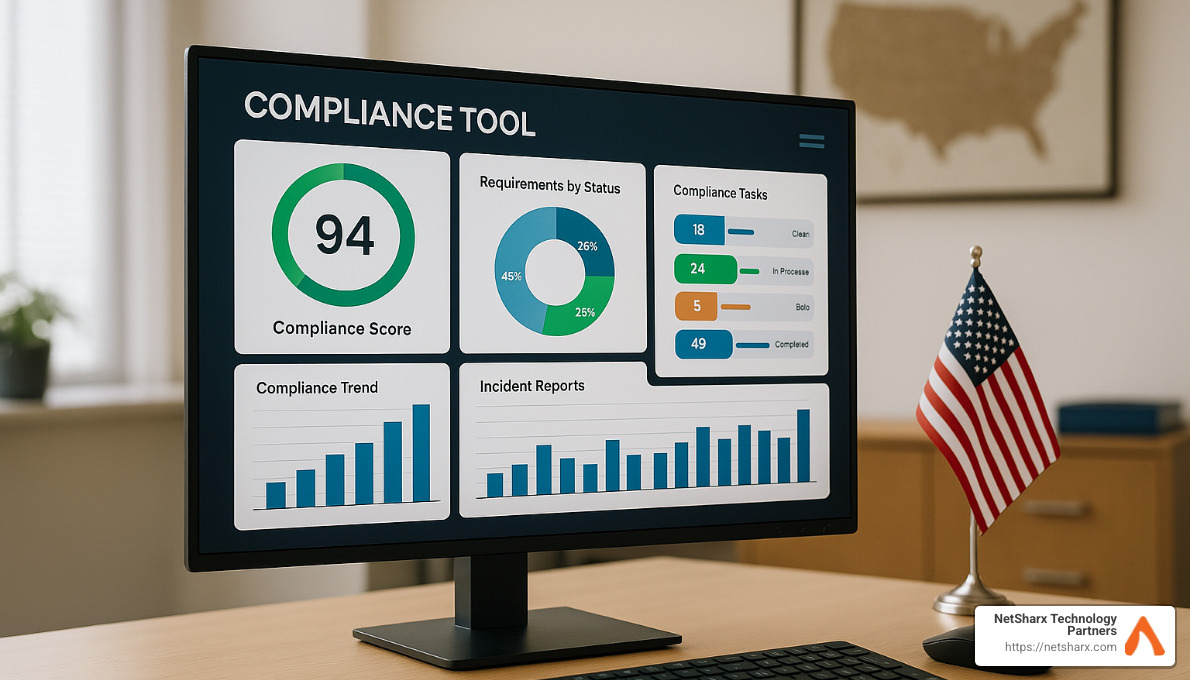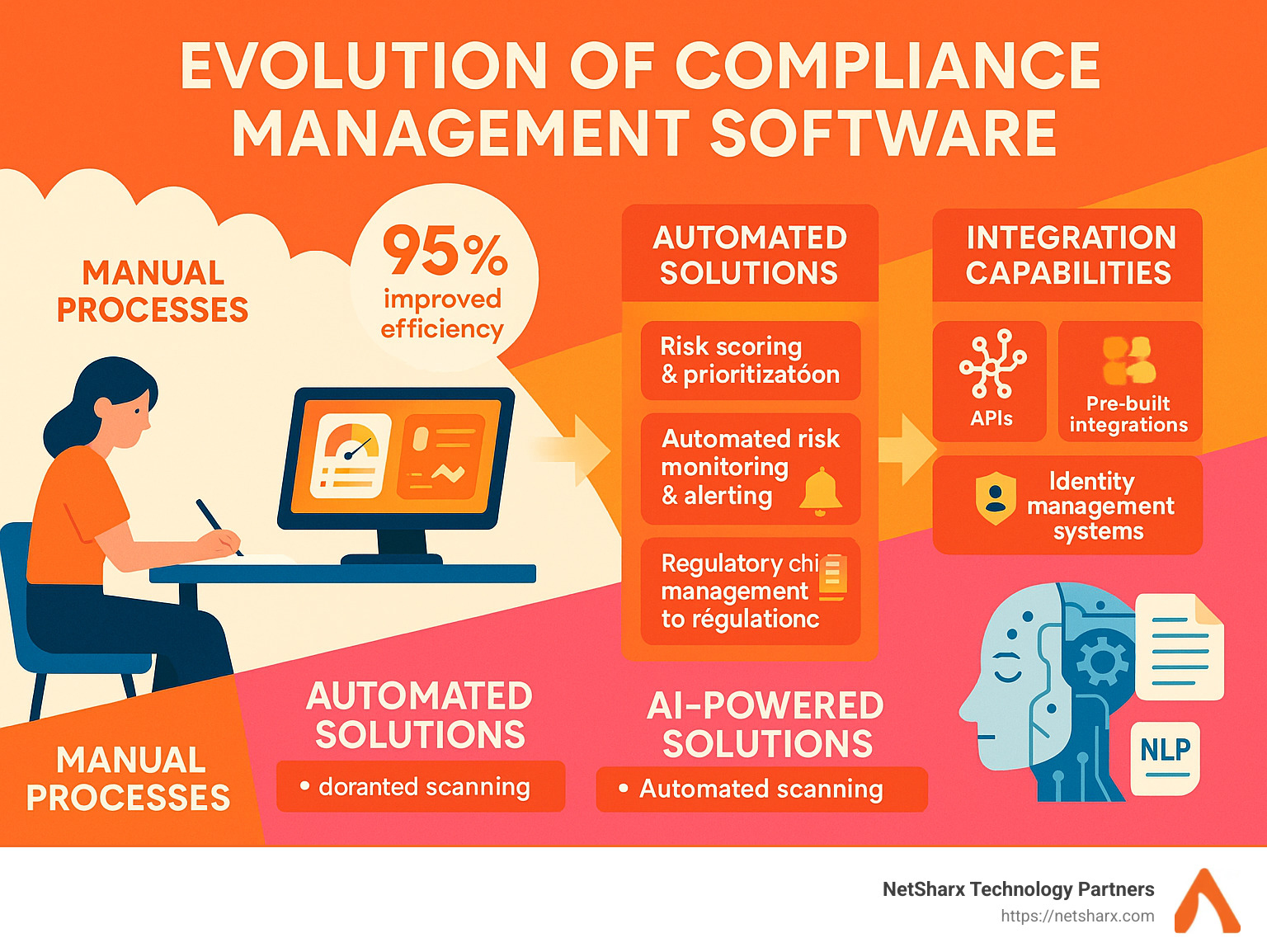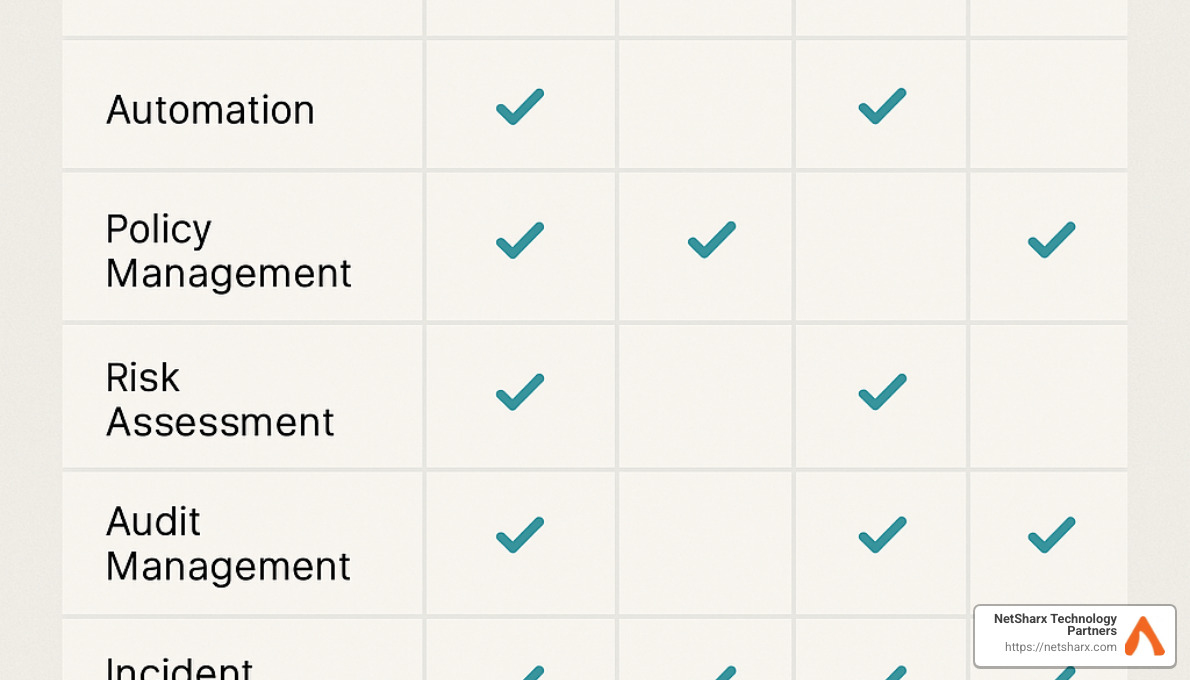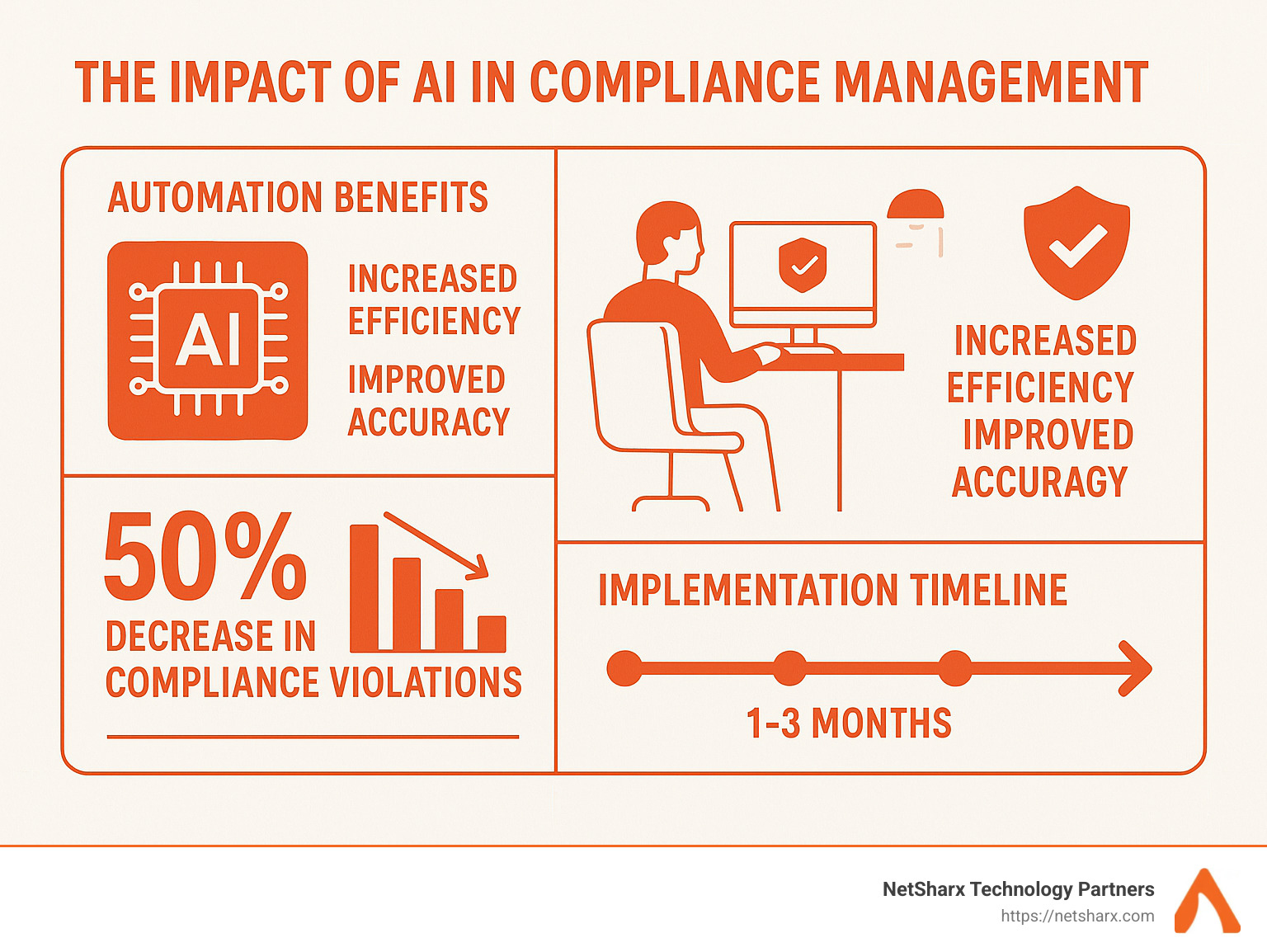Compliance Management Tools: Top 2025 Essential Guide
Navigating the Best Compliance Management Tools in 2025
Compliance management tools help organizations meet regulatory requirements, manage risks, and streamline complex compliance activities through automation. For quick guidance, here are the top compliance management tools CIOs are considering for 2025:
- Vanta – Best for seamless automation and high-quality user experience
- Resolver – Ideal for real-time compliance monitoring and reducing fatigue
- MetricStream – Strong AI/ML integration for proactive compliance
- Hyperproof – Highly rated for ease of use and customer satisfaction
- LogicGate Risk Cloud – Excellent for comprehensive risk visibility
- Onspring – Great for integration with existing systems and scalability
- Compliance.ai – Custom for dynamic regulatory change management
Choosing the right compliance management tools can result in up to a 90% reduction in compliance management activities and 50% fewer compliance issues—helping IT leaders avoid painful audits and costly regulatory fines.
I’m Ryan Carter, the founder and CEO of NetSharx Technology Partners, where I’ve guided numerous mid-market and enterprise clients in selecting and implementing compliance management tools that streamline and simplify regulatory challenges. With my team’s expertise, we’ve successfully reduced compliance burdens, improved risk visibility, and driven tangible efficiency gains.
Compliance management tools terms to remember:
– enterprise identity management
– enterprise network protection
– managed firewall services
Why Compliance Management Tools are Essential in 2025
If you’re feeling overwhelmed trying to manage regulatory compliance manually, trust me: you’re not alone. Think about this for a second—around the world, laws and regulations change more than 50,000 times a year. That’s a lot of paperwork and headaches to handle without help!
That’s why having reliable compliance management tools in your toolkit is no longer optional—it’s essential.
The Evolving Regulatory Landscape
Fast forward to 2025, and the compliance world has only grown more complex. Organizations face a tangled web of regulations across multiple industries, regions, and categories. Data privacy rules like GDPR and CCPA continue to evolve, and industry-specific requirements such as HIPAA (healthcare) or PCI DSS (payment processing) add even more layers of complexity.
Leah Bosé, a Senior Privacy Compliance Manager, summed it up perfectly: “Working with compliance management tools, it almost feels like the sky’s the limit. It’s nice to partner with a team that’s so responsive to what will make our lives easier and sees the value in their customers.”
The High Cost of Non-Compliance
Ignoring compliance isn’t an option—the stakes are just too high. Regulatory fines, lawsuits, and damage to your company’s reputation can quickly spiral out of control.
Here’s some good news: organizations investing in robust compliance management tools typically see a 526% ROI over three years. Even better, these tools usually pay for themselves in just three months! In fact, companies report up to a 129% boost in compliance team productivity once they’ve gone automated.
Danny Macias, VP of IT and Enterprise Security at a mid-sized enterprise, had this to say about his experience: “Our compliance management platform was a game-changer. Not only did it cut our audit time in half, but it also saved us well over six figures. Even better, it helped us build trust with enterprise prospects.”
Beyond Cost Savings: Strategic Benefits
But cost savings are just the beginning. The right compliance management tools deliver strategic advantages well beyond avoiding penalties.
For starters, these tools dramatically reduce compliance fatigue. Instead of chasing down repetitive data requests and drowning in paperwork, your teams can focus on meaningful work. It frees them up for more strategic initiatives, boosting overall operational efficiency.
Additionally, modern compliance platforms offer improved risk visibility, providing real-time insights into potential compliance issues. This proactive approach helps you address problems before they become major headaches.
Another big win? A clear competitive advantage. Strong compliance management demonstrates trustworthiness, boosts your credibility with customers and partners, and helps your business stand out in a crowded field.
Finally, scalability matters. As your organization grows, your compliance demands grow too. Good compliance tools are designed for scalability, seamlessly adapting to new regulations and business requirements without requiring a proportional increase in your compliance team.
At NetSharx Technology Partners, we’ve watched these benefits come to life firsthand. One of our financial services clients reduced their compliance management workload by 70%—while also becoming more audit-ready than ever before. Talk about a win-win!
With compliance demands set to become even more challenging, there’s never been a better time to strengthen your compliance strategy with the right tools. If you’re looking to simplify compliance, boost productivity, and gain peace of mind, investing in comprehensive compliance management is a smart move for 2025 and beyond.
Key Features to Look for in Compliance Management Tools
With regulatory demands growing and evolving faster than ever before, selecting the right compliance management tools for your organization is critical. But with so many options out there, how do you know which features to prioritize?
Let me walk you through the key aspects to look for—so you can confidently pick a tool that makes compliance easier, not harder.
Automation Capabilities
If your compliance tasks still involve endless spreadsheets and manual checklists, it’s time for an upgrade. The best compliance management tools leverage automation to take repetitive tasks off your plate. Think automatic evidence gathering from multiple systems, scheduled compliance checks and control testing, and streamlined workflows for approvals and follow-ups. Oh, and don’t forget automated reporting—your auditors and management team will thank you!
Joe Berglund, Director of IT Operations and Cybersecurity, summed it up perfectly: “Using our compliance management platform, we can accurately measure our compliance and security performance. The automation alone slashed our audit preparation time in half—if not more.”
Centralized Dashboard and Reporting
Ever feel overwhelmed trying to track regulatory requirements across multiple frameworks? A centralized, easy-to-steer dashboard can be your compliance-saving grace. Look for compliance management tools that provide real-time visibility into your compliance status, with simple drill-down features to see exactly where you stand.
Customized reporting is also key. The right tool will let you quickly generate custom reports for executives, auditors, or regulators—saving you hours of headache-inducing prep each quarter.
Real-Time Monitoring and Risk Assessment
In today’s regulatory environment, real-time monitoring isn’t just nice-to-have—it’s essential. The best tools continuously evaluate your compliance posture and risk landscape, giving you instant visibility into potential issues before they become major headaches.
Look for platforms offering built-in risk assessment and management capabilities, like integrated risk scoring, automated alerts, and clear control mapping designed to help you manage compliance proactively. After all, staying ahead of compliance risks is a whole lot easier (and less stressful) than playing catch-up.
Integration Capabilities
Your new compliance platform should play nicely with your existing tech stack. Seamless integration helps ensure smooth data sharing across systems—no more manually copying data between tools. Prioritize compliance management tools that offer APIs, pre-built connections to commonly used enterprise applications, and integrations with enterprise identity management systems. Simplifying your integration strategy means fewer gaps in compliance tracking and reporting.
AI/ML Capabilities
Remember when AI felt futuristic? Well, the future’s here. Modern compliance management tools increasingly harness AI and machine learning, changing complex regulatory compliance into something manageable. AI helps you stay current with ever-changing rules by automatically scanning and categorizing regulatory updates. It can even predict potential compliance risks before they occur, thanks to predictive analytics.
With natural language processing (NLP), you can also simplify policy creation and interpretation—saving your compliance team precious hours typically spent deciphering complicated legal jargon.
User-Friendly Interface
Let’s be honest: even the fanciest compliance tool won’t help you if nobody wants to use it. Intuitive, user-friendly design matters—a lot.
Look for a platform that’s easy to steer right out of the box, with role-based views customized for each team member’s needs. Mobile-friendliness is also crucial for those quick compliance checks or approvals on-the-go. The easier the tool is to use, the faster your team will adopt it—meaning quicker compliance wins.
Scalability and Flexibility
Your organization isn’t standing still—so your compliance solution shouldn’t either. Choose a tool that adapts as your business grows or regulatory requirements change, easily supporting multiple compliance frameworks simultaneously. Customizable workflows, templates, and flexible deployment options (like cloud, on-premises, or hybrid) ensure your compliance management tool stays aligned with your evolving needs.
At NetSharx Technology Partners, we’ve seen how choosing the right compliance tool can make or break your compliance efforts. We help organizations in Minneapolis and beyond select tools that fit their unique industry, company size, and compliance challenges—ensuring compliance management remains straightforward, scalable, and stress-free.
Top Compliance Management Tools for 2025
As compliance demands grow more complex and regulators become increasingly vigilant, having the right compliance management tools becomes critical for your organization’s success. But with dozens of options out there, how do you know which one is right for you?
We’ve done the homework (you’re welcome!) and narrowed it down to the top compliance management tools across three key categories: Governance, Risk, and Compliance (GRC) platforms, industry-specific solutions, and cutting-edge AI-powered compliance tools. Let’s dive right in.
Governance, Risk, and Compliance (GRC) Compliance Management Tools
GRC tools offer an integrated solution that brings together governance, risk management, and compliance into one streamlined platform. They’re ideal if you’re juggling complex regulatory requirements across multiple departments.
One standout is LogicGate Risk Cloud, known for impressive risk visualization and intuitive workflows. It’s especially suited for mid-to-large enterprises facing extensive compliance demands, earning a solid 4.5/5 user rating. A favorite feature? The flexible application builder, allowing you to create custom compliance workflows without coding (great news if your dev team is always “too busy”).
Another powerful choice is MetricStream, particularly for highly regulated industries and large organizations. It leverages strong AI-driven compliance monitoring and regulatory change management, significantly cutting compliance management time (up to 90%!). Users rate it 4.2/5.
Then there’s Resolver, perfect for organizations striving to reduce compliance fatigue. Its centralized compliance dashboard offers real-time visibility, simplifying your life dramatically. Resolver scores a user rating of 4.3/5.
And finally, Archer Regulatory and Corporate Compliance Management provides enterprise-grade compliance management, complete with an extensive library of regulatory controls and audit trails. Ideal for larger enterprises with mature compliance programs, Archer maintains a 4.1/5 rating.
As one Chief Risk and Compliance Officer put it, “The platform is the ideal repository for compliance and regulatory requirements, integrating risk and compliance in an intuitive way.”
Industry-Specific Compliance Management Tools
When generic solutions just aren’t enough, industry-specific tools step in with custom features and built-in regulatory know-how.
If you’re a tech company pursuing certifications like SOC 2 or ISO 27001, Hyperproof is your best friend. It boasts seamless integration with cloud services for automatic evidence collection, significantly reducing manual workload. It’s no wonder users give it an outstanding 4.9/5 rating—the highest in its category.
For banks, credit unions, and financial institutions, Predict360 hits the spot. It provides AI-powered compliance insights and applications purpose-built for financial services. Users praise its effectiveness, giving it a solid 4.4/5.
And for organizations with complex audits and data-intensive compliance needs, HighBond excels with robust analytics and advanced audit management capabilities. With a user rating of 4.3/5, it’s perfect for compliance teams who love data (and lots of it!).
One Director of Compliance, Security, and Strategic Projects shared enthusiastically, “Specialized tools like these automate our compliance program beautifully—tasks, reminders, document uploads—making our lives a whole lot easier.”
AI-Powered Compliance Management Tools
Looking toward the future, AI-powered compliance management tools are dramatically changing the game. They use artificial intelligence to predict compliance risks, automate tedious tasks, and best of all—give compliance teams their weekends back.
Vanta is leading the charge with its incredible automation capabilities and exceptional user experience. Organizations seeking continuous monitoring love its Trust Center, which streamlines vendor assessments with AI-powered questionnaires. Users rate Vanta highly at 4.7/5.
If you’re integrating compliance into your DevSecOps pipeline, RegScale is a fantastic choice. Its “compliance as code” approach means your security efforts stay agile, automated, and proactive—perfect for tech-forward organizations. It holds a 4.5/5 user rating.
Lastly, Complyance leverages AI-first technology to dramatically reduce manual labor. AI features automatically flag risks in vendor questionnaires and even draft client questionnaire responses, making multi-framework compliance easier. It scores a strong 4.4/5 rating from users.
One compliance manager summed up the power of these AI tools perfectly: “The AI features reduced our compliance workload by 70%. Now, we spend our time actually reducing risk—not just checking boxes.”
At NetSharx Technology Partners, we’ve successfully guided many organizations in Minneapolis and beyond through the selection and implementation of these leading compliance management tools. With our vendor-agnostic approach, we always ensure you’re matched with the compliance solution that best fits your organization, industry, and unique needs.
After all, compliance doesn’t have to be painful—at least not when you have the right tools (and the right partner!) by your side.
How to Choose the Right Compliance Management Tool for Your Organization
Picking the ideal compliance management tool is like searching for the perfect pair of shoes—it needs to fit comfortably, suit your unique style, and be capable of handling everyday use plus special occasions. But unlike shoes, the wrong compliance tool can lead to serious headaches (and hefty fines!). Let’s walk through how you can confidently choose the right compliance solution that fits your organization’s specific needs.
1. Assess Your Compliance Requirements
First things first—know exactly what you’re dealing with. Take a moment to clearly map out your compliance landscape. Ask yourself: Which regulations affect us the most? What are the compliance processes that consume the most resources? Identify all the key regulations your organization must follow (such as GDPR, HIPAA, SOC 2, or PCI DSS). Don’t forget to highlight the biggest pain points in your current compliance workflows—these will help you spot areas ripe for automation.
One of our financial services clients was surprised when they finded they were juggling 27 different regulations. Understanding this complexity early helped streamline their compliance solution choice.
2. Define Your Must-Have Features
Not all compliance tools are created equal—some are feature-packed while others focus on simplicity. Think carefully about features your organization can’t live without. Some essential features might include automated compliance monitoring, real-time dashboards, or streamlined evidence collection.
Then consider “high-value additions”—features that significantly improve efficiency, like AI-driven compliance updates or predictive analytics. Finally, make a note of the “nice-to-haves,” bonus features that improve usability but aren’t deal-breakers.
Keep it simple: a good approach is knowing exactly what you need today and what you’ll likely need in the future.
3. Evaluate Integration Requirements
Even the most powerful compliance management tools won’t help if they can’t play nicely with your existing systems. Evaluate how any new tool integrates with your current technology landscape. Will it connect smoothly with your HR platform, cloud services, or IT management systems? Make sure to verify whether the tool comes with built-in integrations or easy-to-use APIs for seamless connectivity.
As one Director of IT Operations put it, “Integration capability was our #1 priority. Half the tools we first considered were quickly off the table because they couldn’t easily talk to our existing systems.”
4. Consider Scalability and Future Needs
Think of your compliance management tool as a member of your team: it has to grow and adapt alongside your organization. Consider how easily the tool can scale as your business demands increase. Can it handle more users, different compliance frameworks, and even geographical expansions without significant disruptions or extra costs? The right tool should be flexible enough to grow with you—no matter where your compliance journey takes you.
5. Evaluate Implementation and Ongoing Support
Implementation can feel like assembling IKEA furniture—simple and straightforward, or complicated and frustrating. Choose a compliance solution with an easy implementation process and manageable timeline. Factor in training requirements and ongoing support from the vendor. Will your team need extensive training sessions, or can they learn quickly through built-in tutorials? What about after deployment—does the vendor offer responsive support, detailed documentation, and ongoing guidance?
A client of ours learned this lesson the hard way when their first choice had a long, overly complex implementation phase. Now they swear by solutions that include clear onboarding processes and readily available ongoing support.
6. Analyze Total Cost of Ownership
Don’t get impressd by a low sticker price; hidden costs can add up quickly. Look beyond just subscription or licensing fees—consider the total cost of ownership. Include professional services, customization expenses, ongoing maintenance, support, training, and even potential future module additions. It’s crucial to calculate when the tool will pay for itself through efficiency gains—this gives you a clearer understanding of its true value.
A CFO we worked with admitted, “We initially focused too much on subscription costs, but implementation expenses varied wildly between vendors. Going deeper into those numbers ended up saving us thousands.”
7. Seek Peer Insights and Expert Guidance
There’s nothing like experience. Tap into your peer network and find out what other organizations in your industry are using and loving. Check out independent analyst reports from respected sources like Gartner and Forrester. Don’t hesitate to request direct customer references from vendors as well, so you can hear both the good and any potential hiccups.
And remember, you’re not alone. Consulting an independent tech advisor (like us at NetSharx Technology Partners!) can provide invaluable guidance. Our Minneapolis-based team has successfully guided numerous organizations toward tools that genuinely fit their unique needs—without vendor bias.
One of our healthcare partners put it best: “NetSharx saved us from a six-figure mistake. Their structured, unbiased approach to evaluating our needs and matching them with the right tool made all the difference. Three years later, we’re still delighted with our choice.”
Ready to make the best compliance management tool decision for your business?
More info about Network Optimization Services
Frequently Asked Questions about Compliance Management Tools
What are Compliance Management Tools?
Compliance management tools are software platforms designed to help businesses stay on top of the countless rules, regulations, and internal policies they must follow. Think of these tools as your friendly compliance assistant—streamlining and automating all those tricky regulatory processes you’re probably tired of handling manually. They help you identify what regulations apply to your business, implement the proper controls, monitor ongoing compliance, and generate useful reports to prove you’re staying within the rules.
Industry experts describe compliance management software as technology that keeps your business safely within industry guidelines, regulatory requirements, and best practices—while saving your team from hours (or days!) of manual compliance work.
There are generally three flavors of compliance management tools you’ll come across:
- All-purpose platforms: These comprehensive tools handle a wide range of compliance areas and are suitable across industries.
- Industry-specific compliance solutions: Custom specifically for industries like healthcare, finance, or manufacturing, these tools come pre-loaded with regulations relevant to your sector.
- Governance, Risk, and Compliance (GRC) software: For teams that need more than just compliance, GRC solutions integrate compliance with broader risk management and governance capabilities.
At NetSharx Technology Partners, we’ve seen how these platforms turn compliance from a dreaded chore into a smooth, proactive process that adds real value to your organization.
How Do Compliance Management Tools Help Automate Compliance Processes?
Automation is the magic ingredient in modern compliance management tools. By taking the repetitive manual efforts out of compliance, these tools make life easier for everyone involved—from compliance officers to IT teams.
Compliance management software typically automates key tasks like evidence collection, so you don’t have to chase down reports or screenshots from dozens of sources. For instance, these tools can automatically gather data from cloud infrastructure, user access systems, or HR applications—saving your team days of effort every audit cycle.
Workflows also become easier. Smart automation assigns tasks, sends reminders, pushes approvals along, and escalates overdue items, meaning no compliance task falls through the cracks.
Continuous monitoring is another major win—these tools don’t just check compliance once a quarter or year; they’re always watching. You’ll get real-time alerts if something isn’t quite right, ensuring you address issues before they become costly problems.
And let’s not forget about reporting. Regular compliance reports become as simple as clicking a button (or even fully automated), creating clear, professional summaries that auditors and executives love.
Finally, these platforms help you stay ahead of regulatory changes. With integrations to regulatory content providers, you’ll know exactly what’s changing and what you need to update—without spending your days reading dense regulatory documents.
At NetSharx, we’ve helped clients automate compliance tasks and reduce their manual compliance workload by up to 90%. That frees them up to focus on strategic initiatives and risk management—while cutting down on stress and overtime.
What Are the Challenges When Implementing Compliance Management Tools?
While compliance management tools are truly game-changing, rolling one out isn’t always a walk in the park. Let’s look at some common challenges, so you can avoid headaches later on.
One of the biggest problems is integrating the tool with your existing systems. Older technology sometimes doesn’t play nicely with new software, making integrations complex and time-consuming. For instance, one of our clients finded their 15-year-old ERP required extensive custom development, turning a two-week plan into a three-month project!
Another frequent issue is data quality. If your existing data is messy or incomplete, even the best compliance management tool can struggle. Getting everyone on the same page with data governance and achieving a “single source of truth” can take time and effort.
Then there’s user adoption—the best tool in the world won’t help if no one uses it. People naturally resist change, and inadequate training or lack of leadership support can make adoption especially tough. One compliance manager told us they had to completely revamp their training program and get senior leaders involved to make their rollout successful.
It’s also easy to go overboard with customization. While tweaks can help a tool fit exactly into your processes, too much customization can make upgrades and maintenance difficult. Finding the right balance between customization and standard features is critical.
Cost management and ROI realization can also trip up teams. Many underestimate the total cost, including implementation, training, integrations, and ongoing support. Having a clear picture of your total cost of ownership (TCO) upfront helps prevent surprises down the road.
Finally, compliance tools require continuous updates and maintenance—regulations keep changing, and your tool must stay current to remain effective. You’ll need ongoing resources to manage these updates, technical maintenance, and periodic user training refreshers.
At NetSharx Technology Partners, we’ve guided businesses through these challenges with careful planning, realistic expectations, and proven methodologies. As one healthcare compliance director put it, “The software itself was only part of the equation. The rest came down to how well we prepared, managed the implementation, and supported our people.”
For additional insights into compliance-related solutions, don’t forget to check out our enterprise identity management, enterprise network protection, and managed firewall services offerings.
Conclusion
Navigating regulatory compliance in 2025 feels a bit like steering a boat through choppy waters—with surprise waves coming from every direction. As we’ve explored throughout this guide, manual approaches to regulatory compliance simply can’t keep up anymore. That’s where modern compliance management tools come into the picture.
Compliance has moved beyond basic checklists and spreadsheets. Today’s tools leverage automation, AI, real-time monitoring, and integrated risk management to help organizations stay ahead of ever-changing regulatory requirements. These advanced solutions transform compliance from a burdensome chore into a valuable strategic advantage.
Staying Ahead in an Ever-Changing Regulatory Landscape
It’s no secret that regulations get more complex every year. New requirements emerge constantly, and penalties for slipping up can sting more than ever before. Without the right tools, compliance teams find themselves overwhelmed, missing important changes, and dealing with stressful audits.
As Joe Berglund, Director of IT Operations and Cybersecurity, shared from his own experience: “Using our compliance management platform, we can accurately and continuously measure our compliance and security performance. The automation reduced our audit preparation time by half—or even more.”
Simply put, having the right compliance tools isn’t optional anymore; it’s essential. The right solution saves you time, reduces headaches, and prevents costly surprises.
Picking a Good Tool is Just the First Step
Choosing the best compliance solution is just the beginning. To get the most from your investment, focus on the keys to successful implementation:
- Executive Buy-In: Make sure your leadership is on board. Clear executive sponsorship can help drive adoption and provide needed resources.
- Clear Goals and Metrics: Define how success will be measured. Even simple metrics can help track progress and demonstrate value.
- Phased Rollout: Start small, focusing on your most urgent compliance needs. Expand methodically to keep things manageable.
- Training and Support: Offer thorough, ongoing training to make sure people actually use the new tools effectively.
- Optimizing Processes: Don’t simply automate old, inefficient workflows. Take time to streamline and improve your processes along the way.
- Regular Reviews: Continuously assess your compliance tool’s effectiveness. Adjust strategy and features as your business evolves.
Looking Toward the Future of Compliance Management
So, what’s next in compliance management? A few exciting trends are on the horizon:
Compliance tools are getting smarter. You can expect even more advanced AI integration soon, which means predictive analytics and faster risk detection.
Compliance-as-code will increasingly integrate compliance checks directly into your development and operational workflows. This helps catch compliance gaps earlier and reduces rework later on.
Expect a shift from yearly audits toward continuous compliance monitoring, giving you real-time visibility into your compliance posture. This means fewer surprises during audits and more peace of mind year-round.
Visualization features will improve too, as vendors focus on creating more intuitive dashboards and easy-to-understand compliance reports.
We’ll also see increased cross-regulatory mapping capabilities, allowing companies to effortlessly manage multiple frameworks simultaneously—saving considerable time and effort.
For more details on broad regulatory compliance frameworks and guidelines, see this external resource.
Expert Guidance from NetSharx Technology Partners
At NetSharx Technology Partners, we know picking the right compliance management tool can feel overwhelming. Our Minneapolis-based team has guided companies of all sizes across industries, helping them find the best solutions to simplify their compliance journey. Because we’re vendor-agnostic, we always recommend what suits you best—never what earns us the highest commission.
Our experienced team will handle the technical complexity of integrating your compliance tool with your existing systems. We support you throughout the entire implementation process and beyond, ensuring your compliance solution delivers real, lasting benefits.
One of our financial services clients recently told us: “NetSharx didn’t just help us pick a compliance tool—they totally transformed our approach to compliance management. Three years later, we’re still finding new benefits.”
Ready to Tackle Your Compliance Challenges?
The truth is, regulatory compliance isn’t going to get easier. But with the right compliance management tools, your organization can transform compliance from a cost center into a true competitive advantage. The perfect solution will improve your decision-making, boost operational efficiency, and build trust with your customers and partners.
If you’re ready to simplify compliance and stay ahead of regulatory changes, our team would love to help.
More info about our cybersecurity services
Learn how NetSharx Technology Partners can help you steer compliance challenges
Don’t steer the complexities of compliance management alone. Contact our friendly team at NetSharx today. We’ll help you evaluate your options, implement the right solution, and provide ongoing support, ensuring compliance management becomes one less thing you need to worry about.










